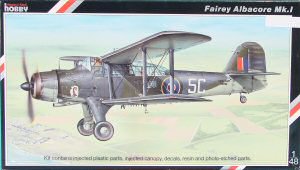
Special Hobby 1/48 Fairey Albacore Mk.I Kit First Look
By Michael Benolkin
| Date of Review | January 2007 | Manufacturer | Special Hobby |
|---|---|---|---|
| Subject | Fairey Albacore Mk.I | Scale | 1/48 |
| Kit Number | 48045 | Primary Media | Styrene, Resin, PE |
| Pros | The kit is 90% styrene, easy assembly, great detailing! | Cons | |
| Skill Level | Intermediate | MSRP (USD) | $63.00 |
First Look
 |
 |
 |
 |
 |
 |
The Fairey Albacore was designed in the late 1930s as a replacement for the Fairy Swordfish (aka 'stringbag') and offered more power, fully enclosed cockpit and crew stations. Unfortunately, the improvements were better on paper than in practice and while around 800 examples were produced, the aircraft stayed in service for a relatively short time and was replaced by the Fairey Swordfish - the aircraft that the Albacore was supposed to replace!
The aircraft did see combat primarily in the Mediterranian theater with Operation Torch and other operations in the early 1940s. Like the Gloster Gladiator and other biplanes in service with other air forces at that time, the Albacore was outclassed by higher performance monoplanes.
The Special Hobby 1/48 scale Fairey Albacore kit is a simple kit, even though it is technically a limited-run multimedia project. When you look inside the box, it looks like a contemporary Classic Airframes kit. Considering the subject, I was rather surprised that Classic Airframes didn't release this one. Nevertheless, the kit is crisply molded and presented on four parts trees, plus one clear tree containing clear parts. In addition to the styrene parts, one fret of photo-etched parts, one acetate instrument sheet, and a small bag of resin parts round out the kit.
In fact, the only thing done in resin in this release is the fourteen cylinder Bristol Taurus engine. The photo-etched parts are really limited to seatbelts/harnesses, radar antennae, instrument panel, two interior bulkheads, and a few small details. In other words, this isn't a complex multi-media kit. Even the canopies are represented as a styrene part rather than vacuformed.
Detailing on the fuselage and wings are done just right for a fabric-covered aircraft. There isn't heavy texturing nor are the wings' ribs bulging through unrealistically. Well done!
So while technically a multimedia kit, this is a simple enough build that it would be ideal for the less-experienced modeler to try their hand and mixed media modeling. This is still rated as an intermediate-level kit as modeling skills are required to trim and fit the parts together. If you’ve built a few Classic Airframes kits, this will feel right at home.
Markings are included for three examples:
- Albacore Mk.I, X9053/5C, 817 Sqn, 1943-44
- Albacore Mk.I, X8942, 828 Sqn, Malta, late 1942
- Albacore Mk.I, L7114, 'Mona II', Lt Cdr Tuke, English Channel area, 1940
If you're looking to try out multimedia modeling, this is a good trainer for you. Remember to dry-fit your subassemblies frequently as the sooner you identify a potential problem, the more likely the problem will be avoided or mitigated quickly.
Also remember that resin and photo-etched parts will not respond to liquid cement, so cyanoacrylate (Crazy Glue) will be required to attach these parts to the styrene portions of the model.







